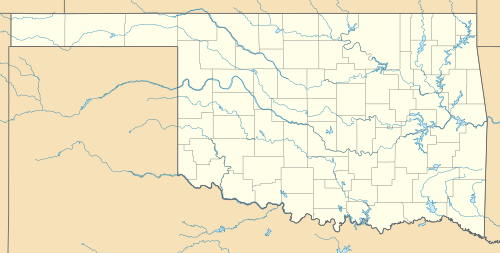Murrell Home
|
Murrell Home | |
|
Murrell Home | |
 | |
| Location | Park Hill, Oklahoma |
|---|---|
| Coordinates | 35°51′20.24″N 94°57′32.43″W / 35.8556222°N 94.9590083°WCoordinates: 35°51′20.24″N 94°57′32.43″W / 35.8556222°N 94.9590083°W |
| Built | 1844-5 |
| Architect | Unknown |
| Architectural style | Federal |
| NRHP Reference # | 70000530[1] |
| Significant dates | |
| Added to NRHP | June 22, 1970[2] |
| Designated NHL | May 30, 1974[3] |
The Murrell Home, also known as the George M. Murrell Home, is a historic home and museum in Park Hill, near Tahlequah, Oklahoma in the Cherokee Nation. It was built in 1845 and was most likely constructed by African-American slaves brought west by the owners. It is an emblem of the elite among the Cherokee in the mid-nineteenth century.[4]
The mansion was built by George Michael Murrell, a wealthy white planter and merchant married to Minerva Ross, the niece of prominent Cherokee leader John Ross.[5] He called it Hunter's Home. The Murrells came to Indian Territory about the time of the Trail of Tears (1839). They furnished their house with the latest in fashions. They held 42 slaves, whom they housed in nine cabins on the large property.[4]
During the American Civil War, the area surrounding the Murrell Home was frequently raided by forces loyal to both the Union and Confederacy. The Murrell Home was spared destruction during this turbulent time and was the only local building to survive the conflict.
Cherokee Jennie Ross Cobb (1881–1959), one of the earliest Native American photographers, later lived in the Murrell Home and helped direct restoration of the house.[5][6] The house was declared a National Historic Landmark in 1974.[3]
The building is operated by the Oklahoma Historical Society as a historic house museum and has been furnished reflecting the period 1830s-1860s. The Daniel Cabin is a log cabin on the property; it is used for living history demonstrations of Cherokee life in the 1850s. The property also features a 45-acre (180,000 m2) park with trails.
See also
References
- ↑ "Oklahoma Historical Society State Historic Preservation Office".
- ↑ National Park Service (2007-01-23). "National Register Information System". National Register of Historic Places. National Park Service.
- 1 2 "Murrell Home". National Historic Landmark summary listing. National Park Service. Retrieved 2007-10-11.
- 1 2 Tiya Miles, Ties that Bind: The Story of an Afro-Cherokee Family in Slavery and Freedom, University of California Press, 2005, p. 181
- 1 2 "Murrell Home." Cherokee Nation Tourism. (retrieved 21 March 2010)
- ↑ Tsinhnahjinnie, Hulleah J. and Veronica Passalacqua, eds. Our People, Our Land, Our Images: International Indigenous Photography. Berkeley: Heyday Books, 2008: 4-5. ISBN 978-1-59714-057-7.
External links
- Official website
- George M. Murrell Home at Oklahoma Historical Society
- George M. Murrell Home at TravelOK.com, featuring info, photos, and video
- Historic American Buildings Survey (HABS) No. OK-28, "George M. Murrell House, Murrell Road, at junction of Willis Road, Park Hill vicinity, Cherokee County, OK", 20 photos, 1 color transparency, 9 measured drawings, 15 data pages, 3 photo caption pages
